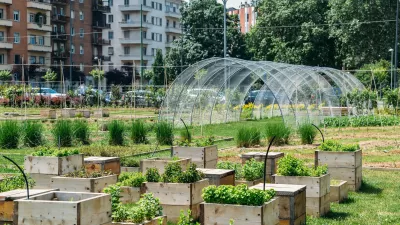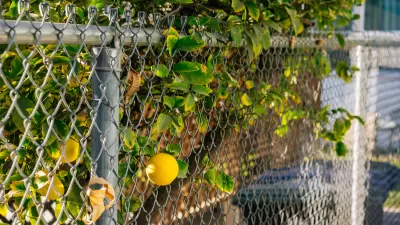In this excerpt from their new book, The Urban Homestead, authors Kelly Coyne and Erik Knutzen point out all the ways city dwellers can move away from industrial agriculture.
"The idea of urban farming is nothing new. Back in the days before freeways and refrigerated trucks, cities depended on urban farmers for the majority of their fresh food. This included small farms around the city, as well as kitchen gardens.
The United States once was a nation of independent farmers. Today most of us do not know one end of a hoe from the other. In the last half of the 20th century, a cultural shift unique in human history came to pass. We convinced ourselves that we didn't need to have anything to do with our own food. Food, the very stuff of life, became just another commodity, an anonymous transaction.
So what are the strategies urban homesteaders can follow? As a homesteader, you will begin to see any open space as a place to grow food. This includes front yards as well as backyards, vacant lots, parkways, alleyways, patios, balconies, window boxes, fire escapes and rooftops...The truth is that you can grow a hell of a lot of food on a small amount of real estate. You can grow food whether you're in an apartment or a house, whether you rent or own."
FULL STORY: How You Can Start a Farm in Heart of the City

Planetizen Federal Action Tracker
A weekly monitor of how Trump’s orders and actions are impacting planners and planning in America.

Maui's Vacation Rental Debate Turns Ugly
Verbal attacks, misinformation campaigns and fistfights plague a high-stakes debate to convert thousands of vacation rentals into long-term housing.

San Francisco Suspends Traffic Calming Amidst Record Deaths
Citing “a challenging fiscal landscape,” the city will cease the program on the heels of 42 traffic deaths, including 24 pedestrians.

Defunct Pittsburgh Power Plant to Become Residential Tower
A decommissioned steam heat plant will be redeveloped into almost 100 affordable housing units.

Trump Prompts Restructuring of Transportation Research Board in “Unprecedented Overreach”
The TRB has eliminated more than half of its committees including those focused on climate, equity, and cities.

Amtrak Rolls Out New Orleans to Alabama “Mardi Gras” Train
The new service will operate morning and evening departures between Mobile and New Orleans.
Urban Design for Planners 1: Software Tools
This six-course series explores essential urban design concepts using open source software and equips planners with the tools they need to participate fully in the urban design process.
Planning for Universal Design
Learn the tools for implementing Universal Design in planning regulations.
Heyer Gruel & Associates PA
JM Goldson LLC
Custer County Colorado
City of Camden Redevelopment Agency
City of Astoria
Transportation Research & Education Center (TREC) at Portland State University
Jefferson Parish Government
Camden Redevelopment Agency
City of Claremont





























